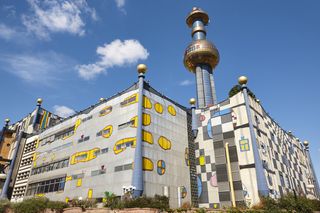Discover how heat from a rubbish tip is being used to heat and cool homes through ‘absorption cooling’
District cooling is a highly efficient method of air conditioning and is being adopted worldwide

It seems burning rubbish could be the future to keeping our houses warm (and cool) as a waste incinerator plant in Vienna, Austria, is doing just that.
The plant uses the heat it generates to power district cooling – where towns and cities are serviced by large and energy-efficient centralair conditioningsystems.
Burning rubbish at the Spittelau waste-to-energy plant powers an absorption chiller, which uses a thermodynamic process called absorption cooling that allows water to be chilled and distributed for heating, ventilation and air conditioning (HVAC) needs.
Energy firm Wien Energie Fernwärme now plans to install further capacity in Spittelau because of demand and also to build up new schemes. We explain how it works, its benefits and how likely it is we will see a similar scheme come to the UK.
How does absorption cooling work?
Heat can be used to power absorption chillers using a thermodynamic process that allows water to be chilled and distributed for HVAC needs.
It uses water mixed with either ammonia or lithium bromide, with lithium bromide the more common choice because it is not toxic.
This mixture is pumped through the heat exchanger to the generator tank and the waste heat separates the lithium bromide and water.
The water gradually becomes vapour and rises to the top, where the condenser is located, and the lithium bromide sinks to the bottom and flows back to the absorber. The vapour goes through a cooling tower and becomes colder water again as the air pressure decreases. This water is then distributed to properties via pipes to use forheating.
What are the benefits of absorption cooling?
Individual air conditioning units for each building or home consume a lot of electricity on hot days, which can overload energy grids and contribute to the triggering of blackouts, to say nothing of the financial and environmental cost of the energy.
在郊区Spittelau吸收冷却,如’s use of waste heat in absorption systems, reportedly delivers CO2 savings of about 79% when compared to conventional building air conditioning systems, which could provide greatenergy saving tips对于那些希望降低bills.
The cooling is delivered to customers via district cooling pipelines with only minor efficiency losses. Additionally, customers no longer need their own cooling plants for the system, reducing maintenance costs.

Is it available in the UK?
The global district cooling market size is projected to grow from £23billion in 2023 to £36.27billion by 2030, at a compound annual growth rate of 6.72% during the forecast period, according toFortune Business Insights.
British homes are generally not designed to cope with heat for obvious reasons, but as temperatures creep upwards many of us will be looking at investing in air conditioning.
District cooling powered by absorption chillers fired by waste energy or geothermal energy could make sense in the UK as part of its push to reduce energy bills.
Get the Homebuilding & Renovating Newsletter
Bring your dream home to life with expert advice, how-to guides and design inspiration, direct to your inbox.
Sam is based in Coventry and has been a news reporter for nearly 20 years. His work has featured in the Mirror, The Sun, MailOnline, the Independent, and news outlets throughout the world. As a copywriter, he has written for clients as diverse as Saint-Gobain, Michelin, Halfords Autocentre, Great British Heating, and Irwin Industrial Tools. During the pandemic, he converted a van into a mini-camper and is currently planning to convert his shed into an office and Star Wars shrine.
Most Popular

BySam Webb
Bring your dream home to life with expert advice, how-to guides and design inspiration, direct to your inbox.
Thank you for signing up to Homebuilding. You will receive a verification email shortly.
There was a problem. Please refresh the page and try again.
